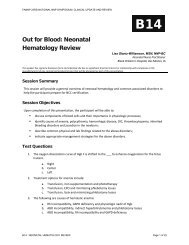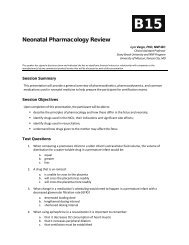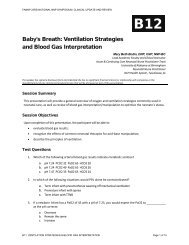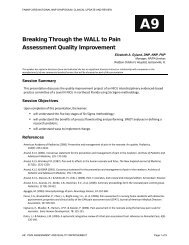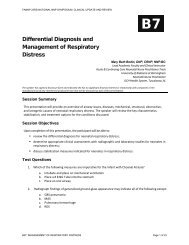Neonatal Nurse Practitioner Symposium: - FANNP
Neonatal Nurse Practitioner Symposium: - FANNP
Neonatal Nurse Practitioner Symposium: - FANNP
You also want an ePaper? Increase the reach of your titles
YUMPU automatically turns print PDFs into web optimized ePapers that Google loves.
8<br />
SAFE continued from page 7<br />
admitted to the hospital under the safe<br />
abandonment law are presumed eligible for<br />
Medicaid coverage. Healthcare coverage<br />
for these children is covered under the<br />
State Children’s Health Insurance Program.<br />
(SCHIP). The State Children’s Health<br />
Insurance Program (SCHIP) was created,<br />
and been widely acclaimed for its success in<br />
reducing the number of children without<br />
health insurance. The Administration<br />
is committed to making sure that poor<br />
children have health insurance. At the<br />
end of 2007, President Bush signed an<br />
extension of the program to cover current<br />
enrollment levels through March 2009 so<br />
that problematic issues could be fixed in the<br />
program prior to further extension.<br />
Since 2000, at least 98 infants have<br />
been safely abandoned, in Florida alone,<br />
since the safe haven laws have been<br />
established to this law. During the same<br />
time period, 38 infants are known to have<br />
been unsafely abandoned; 14 of those<br />
infants lived and 24 died. Locations for the<br />
unsafe abandonment’s included trash cans,<br />
dumpsters, churches, a nursing home, a<br />
hotel room, a beach, a vacant lot, the front<br />
porch of a private home, a hotel garage, a<br />
concrete pile, and a canal.<br />
Many states have passed Safe Haven<br />
legislation in response to the tragedy, which<br />
causes the death of a newborn. The names<br />
of these laws differ from state to state: Safe<br />
Haven, Safe Place, Baby Moses Law, Safe<br />
Arms for Newborns and Safe Delivery.<br />
Before the states passed Safe Haven<br />
laws, about 33 newborns were abandoned in<br />
Texas; 33 in Illinois; 10 in Washington State<br />
and 7 in Massachusetts. One out of three<br />
abandoned newborns did not survive. The<br />
best option is for a birth mother to contact<br />
a licensed adoption agency, such as adoption<br />
services; however, this is not always the case.<br />
Safe haven drop off for infants is an option<br />
and generally allow the biological parent to<br />
remain anonymous and to be shielded from<br />
prosecution for abandonment or neglect. In<br />
most states custody of the infant who has<br />
been placed in a safe haven is transferred to<br />
the state child welfare or child protective<br />
services department and then placed into<br />
foster care.<br />
When faced with an unwanted<br />
pregnancy, political and social climate of<br />
race and ethnicity plays a role in a woman’s<br />
decision-making process and she may feel<br />
there are limited options available to her<br />
in dealing with the situation Mental health<br />
disorders account for a portion of the<br />
incidents in which newborns are disposed of<br />
in public places and occasionally mutilated<br />
or murdered. Religious and ethnic beliefs<br />
can influence a mother’s actions and form<br />
the model of what is acceptable behavior. If<br />
the infant is found in a state of neglect or<br />
abuse, the mother may receive a sentence<br />
from probation to life in prison. A number<br />
of community awareness plans have surfaced<br />
in an effort to address various aspects of the<br />
problems regarding newborn abandonment.<br />
Additional research is needed to<br />
identify which women might be at risk<br />
to abandon a newborn and why. <strong>Nurse</strong>s,<br />
caring for women every day, are in a<br />
unique position to answer these questions<br />
and carry out research programs to find<br />
further answers. The nurses, who are not a<br />
researcher, can support the researchers who<br />
are conducting studies and is a consumer of<br />
research to improve the come of newborns,<br />
families.<br />
The story of abandoned infants is not<br />
one of failure. In Florida, the State Health<br />
Department was primarily the responsible<br />
agency for creating educational materials<br />
and training (Baby? Don’t panic you are<br />
not alone we’re here to help, 2000). The<br />
Safe Haven Foundation has also produced<br />
public service announcements, training<br />
videos for safe haven locations, videos for<br />
schools, signs, and billboards. Getting the<br />
message about the law to pregnant women<br />
in crisis is crucial. The public needs to be<br />
aware that these laws are in place, so more<br />
people will take advantage of it. Respecting<br />
the mother’s confidentiality is what this law<br />
has going for it. When pregnant women are<br />
going through a crisis and need help; they<br />
do not want their name revealed.<br />
Safe Haven provides an alternative<br />
to a frightened parent or parents, who<br />
may do something drastic in a moment<br />
of desperation, destroying two lives, hers<br />
and her babies. It is now a Florida Law,<br />
which allows a mother/ father an alternative<br />
to infant abandonment, with your<br />
confidentiality protected. As Florida’s Safe<br />
Haven Protection law celebrates the 100th<br />
life saved, let all states advocate for infant<br />
safety and initiate Safe Haven Laws.<br />
References<br />
American Civil Liberties Union. (2003). Safe<br />
surrender or infant abandonment legislation.<br />
Retrieved June 3, 2008 from, http://www.aclu.org/<br />
womensrights/parenting/13170res20030122.htmlA<br />
Atwood, T. C. (2008). Comment: National Council<br />
for Adoption’s Response to the Texas Safe Haven<br />
Study. Child Maltreatment, 13(1), 96-97.<br />
Bastard Nation: The adoptee Rights Organization.<br />
(n.d.). Bastard nation. Retrieved July 1, 2008 from,<br />
http://www.bastards.org<br />
Bolling, I.M. (2003). National Center for<br />
State Courts Adoption Trends in 2003: Infant<br />
Abandonment and Safe Haven Legislation. Retrieved<br />
May 29, 2008 from, http://www.ncsconline.org/WC/<br />
Publications/KIS_Adopt_Trends03Haven.pdf<br />
Bradley, D. (2003). Perspectives on newborn<br />
abandonment. Pediatric Emergency Care (2):108-<br />
111.<br />
Center for Medicare & Medicaid services. (n.d.).<br />
State Children’s Health Insurance. Retrieved<br />
June 20, 2008 from, http://www.cms.hhs.gov/<br />
MedicaidGenInfo<br />
Cesario, .S.K. (2001). Newborn abandonment.<br />
Would you know what to do? AWHONN Lifelines,<br />
Oct-Nov; 5(5):42-48.<br />
Cesario, S.K. (2003). <strong>Nurse</strong>s’ Attitudes<br />
and Knowledge of Their Roles in Newborn<br />
Abandonment. Journal of Perinatal Education,<br />
12(2):31-40.<br />
Child welfare information gateway. (2003). Infant<br />
safe haven laws, Retrieved June 6, 2008 from, http://<br />
www.childwelfare.gov/systemwide/laws/policies/<br />
statutes/safehaven.cfm<br />
Child Welfare Project. (2003). Update: Safe haven<br />
for abandoned infants. Retrieved June 1, 2008 from,<br />
http://www.ncsl.org/programs/cyf/slr268.htm<br />
Florida Department of Health. (2000). Baby? Don’t<br />
panic you are not alone we’re here to help. Retrieved<br />
July 10, 2008 from, http://www.doh.state.fl.us<br />
Florida’s Healthy Start, 2008. Safe haven for<br />
newborns 24 hour confidential hotline, 2008.<br />
Retrieved June 7, 2008 from, http://www.<br />
healthystartflorida.org/directory/coalition.asp/<br />
CoalitionID=HSSWF.<br />
Guttermacher Institute, (2008). State policies in brief<br />
Infant abandonment: Retrieved June 6, 2008 from,<br />
http://www.guttermacher.org/pubc/spib<br />
Relating to Surrendered Newborn Infants/Safe Haven<br />
Protection [SPCC], Senate 1704, § CS/SB 1704<br />
(2008).<br />
Safe Haven Protection for Surrendered Newborn<br />
Infant, HB 7007, § PCB HCC 08-13, (2008).<br />
The Baby Moses Project, 1999. The baby moses<br />
project: Background and purpose. Retrieved May 29,<br />
2008 from, http://www.babymosesproject.org



